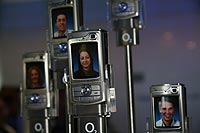 |
||
 |
||
|
|
||
|
Whilst we still await the full publication of the Interphone Mobile Phone study into the health risks associated with mobile phone use, a study by an award-winning Australian neurosurgeon and cancer expert Dr Vini Khurana concludes yet again that using handsets for 10 years or more can double the risk of brain cancer developing on the side of the head predominantly used by those making calls via a mobile phone. He conducted a 15-month "critical review" of more than 100 studies on the effects of mobile phones on health and the link between mobile phones and malignant brain tumours. Furthermore, he goes further in concluding that “Blue Tooth headsets and unshielded wired ear headsets can convert the user's head into an effective, potentially self-harming antenna.” Cordless handsets using DECT technology are also mentioned as a source of potential risk to health due to the same electromagnetic radiation being emitted from them and a far longer exposure level due to the length of most domestic calls in comparison to those via a mobile phone: "One important source of low-level continuous exposures to radio frequency electromagnetic fields (RF EMFs) is base stations of cordless phones that are located indoors, e.g., the Digital Enhanced Cordless
Telecommunications (DECT) standard, operating at about 1900 MHz. These devices (both handset and base station) operate with 250 mW maximum power output, with their base stations continuously emitting pulsed radio frequency radiation irrespective of the handset being in operation or not, and often with the base station being kept close to the bed head at night. ….. these fields are present long term
He said the time between the commencement of regular mobile phone usage to the diagnosis of a malignant solid brain tumour might be in the order of 10-20 years, and that the link between mobile phones and brain tumours had not yet been "definitively proven" because widespread mobile phone usage commenced in the mid-1980s and solid tumours might take several years to form. In conclusion, his report argues that there is already enough evidence to warrant industry and governments taking immediate action to reduce mobile phone users' exposure to electromagnetic radiation and inform them of potential dangers: Despite this defense by the industry in the UK, which sounds vaguely familiar to that of the tobacco industry decades ago, several European countries take the issue more seriously. The French government has issued warnings against the use of mobile phones, especially by children. Germany also advises minimum handset use, and the European Environment Agency have demanded a reduction in the internationally accepted levels of exposure to electromagnetic radiation emitted by mobile devises such as mobile phones and DECT type cordless phones used in the office and home. Even the Stewart Report in the UK recommended a 'precautionary approach' to mobile phone use and children, first published in May 2000. Dr Khurana’s paper contains several recommendations to aid the public in relation to minimising the health risks from mobile phones: He has the the following advice for those in the Telecommunications Industry: You can download the research paper Mobile Phones and Brain Tumours – A Public Health Concern, Vini Gautam Khurana PhD, FRACS here Source: Sydney Morning Herald / The Independent / Research paper: Mobile Phones and Brain Tumours – A Public Health Concern
|
||
 "The "incubation time" or "latency" (i.e., the time from commencement of regular mobile phone usage to the diagnosis of a malignant solid brain tumour in a susceptible individual) may be in the order of 10-20 years. In the years 2008-2012, we will have reached the appropriate length of follow-up time to begin to definitively observe the impact of this global technology on brain tumour incidence rates."
"The "incubation time" or "latency" (i.e., the time from commencement of regular mobile phone usage to the diagnosis of a malignant solid brain tumour in a susceptible individual) may be in the order of 10-20 years. In the years 2008-2012, we will have reached the appropriate length of follow-up time to begin to definitively observe the impact of this global technology on brain tumour incidence rates." Dr Khurana, who since 1994 has received 14 awards and published more than three dozen scientific papers is quoted by the Sydney Morning Herald as saying that the world's heavy reliance on mobile phones could be a greater threat to human health than smoking and even asbestos. He based this opinion on the fact that three billion people now use mobile phones worldwide, three times as many as smoke. Smoking kills some five million worldwide each year, whilst asbestos exposure related illness is responsible for as many deaths in the UK as the number in road accidents.
Dr Khurana, who since 1994 has received 14 awards and published more than three dozen scientific papers is quoted by the Sydney Morning Herald as saying that the world's heavy reliance on mobile phones could be a greater threat to human health than smoking and even asbestos. He based this opinion on the fact that three billion people now use mobile phones worldwide, three times as many as smoke. Smoking kills some five million worldwide each year, whilst asbestos exposure related illness is responsible for as many deaths in the UK as the number in road accidents.